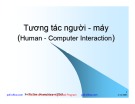
XỬ LÝ ẢNH TRONG CƠ ĐIỆN TỬ
Machine Vision
1
TRƯỜNG ĐẠI HỌC BÁCH KHOA HÀ NỘI
Giảng viên: TS. Nguyễn Thành Hùng
Đơn vị: Bộ môn Cơ điện tử, Viện Cơ khí
Hà Nội, 2021

2
Chapter 2. Digital Image Fundamentals
1. Image Sensing and Acquisition
2. Image Sampling and Quantization
3. Some Basic Relationships Between Pixels
4. Basic Mathematical Tools Used in Digital Image Processing

3
1. Image Sensing and Acquisition
❖Image Sensing and Acquisition
(a) Single sensing element
(b) Line sensor
(c) Array sensor
Rafael C. Gonzalez, Richard E. Woods, “Digital image processing,” Pearson (2018).

4
1. Image Sensing and Acquisition
❖Image Acquisition Using a Single Sensing Element
Rafael C. Gonzalez, Richard E. Woods, “Digital image processing,” Pearson (2018).
Combining a single sensing element with mechanical motion to generate a 2-D image.

5
1. Image Sensing and Acquisition
❖Image Acquisition Using Sensor Strips
Rafael C. Gonzalez, Richard E. Woods, “Digital image processing,” Pearson (2018).
(a) Image acquisition
using a linear sensor strip
(b) Image acquisition using
a circular sensor strip












![Trắc nghiệm Mạch điện: Tổng hợp câu hỏi và bài tập [năm hiện tại]](https://cdn.tailieu.vn/images/document/thumbnail/2025/20251118/trungkiendt9/135x160/61371763448593.jpg)













